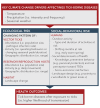N Increased risk of tick-borne diseases with climate and environmental changes
- PMID: 31285697
- PMCID: PMC6587693
- DOI: 10.14745/ccdr.v45i04a02
N Increased risk of tick-borne diseases with climate and environmental changes
Abstract
Climate warming and other environmental changes have contributed to the expansion of the range of several tick species into higher latitudes in North America. As temperatures increase in Canada, the environment becomes more suitable for ticks and the season suitable for tick activity lengthens, so tick-borne diseases are likely to become more common in Canada. In addition to Lyme disease, four other tick-borne diseases (TBDs) have started to emerge and are likely to increase: Anaplasmosis; Babesiosis; Powassan virus; and Borrelia miyamotoi disease. Increased temperature increases the survival and activity period of ticks, increases the range of both reservoir and tick hosts (e.g. mice and deer) and increases the duration of the season when people may be exposed to ticks. Other ticks and TBDs may spread into Canada as the climate changes. The public health strategies to mitigate the impact of all TBDs include surveillance to detect current and emerging TBDs, and public health actions to prevent infections by modifying environmental and social-behavioral risk factors through increasing public awareness. Clinical care strategies include patient education, early detection, laboratory testing, and treatment.
Keywords: Anaplasma phagocytophilum; Anaplasmosis; Babesia microti; Babesiosis; Powassan virus; and Borrelia miyamotoi; climate change; tick-borne disease.
Conflict of interest statement
Conflict of interest: None.
Figures
References
-
- Kilpatrick AM, Dobson AD, Levi T, Salkeld DJ, Swei A, Ginsberg HS, Kjemtrup A, Padgett KA, Jensen PM, Fish D, Ogden NH, Diuk-Wasser MA. Lyme disease ecology in a changing world: consensus, uncertainty and critical gaps for improving control. Philos Trans R Soc Lond B Biol Sci 2017. Jun;372(1722):20160117. .10.1098/rstb.2016.0117 - DOI - PMC - PubMed
-
- Werden L, Lindsay LR, Barker IK, Bowman J, Gonzales EK, Jardine CM. Prevalence of Anaplasma phagocytophilum and Babesia microti in Ixodes scapularis from a newly established Lyme disease endemic area, the Thousand Islands region of Ontario, Canada. Vector Borne Zoonotic Dis 2015. Oct;15(10):627–9. .10.1089/vbz.2015.1792 - DOI - PubMed
LinkOut - more resources
Full Text Sources
Research Materials



